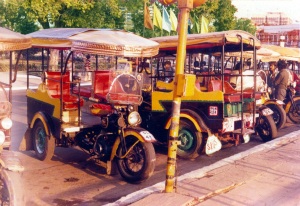The Phatphatis of Delhi
There is something about history that is fascinating. When one mentions this word, though, the thoughts that come to mind are about cultures, architecture, language and traditions.
There are certain other aspects that are interesting, too, though not as well documented.
A ride by a three-wheeler autorickshaw in India is commonplace and would usually not attract any attention. However, there is a particular breed of three wheeler that had left an indelible imprint in the minds of people who were fortunate to have experienced it. This was the “phatphatis” or “phatphats” of Delhi.
When you speak of three wheeler, one visualizes a light weight vehicle that, at times, feels extremely unstable.
The “phatpati” on the other hand was quite something else.
Legend has it that British troops had left behind several Harley Davidson motorbikes when they departed from India. Some enterprising Indians purchased these bikes, added on a gear box (probably from a Willys jeep), welded on a passenger compartment that was good for four passengers, and put the highly unusual and unconventional vehicle onto the roads of Delhi as a “taxi” of sorts.
Travelling in one of these “phatphatis” was a delight. Driven (ridden?) often by a burly Sardarji or a Haryanvi Jat, these vehicles would emit a deep staccato bellow that gave it the name “phatphati” or “phatphat”.
The driver straddled the vehicle as one would a motor cycle. The passengers in front faced forward, while those at the rear faced the rear. The vehicle had a roof made of tarpaulin covered in plastic and the sides had no windows – just an opening.
And, they would travel at a fair nick, navigating from Connaught Place through the crowded streets of Karol Bagh or Green Park. Through Daryaganj to Chandni Chowk, too.
As time went by, a fifth seat was added on and, later, a sixth. Economics, pure and simple, coupled with the increased cost of maintenance. Over time, the original Harley was unrecognizable, but the ingenuity of the owners ensured that these contraptions stayed on the roads.
A law, in 1998, requiring polluting vehicles to get off the roads rang the death knell for these vehicles that were the preferred mode of transport for thousands of daily office goers.
The “phatphati” is gone, it is history. The story of its existence for close on fifty years may never get documented in detail. There might be a few of these still in existence in the hands of collectors.
As someone who has travelled several times by this mode, I will remember it fondly.
The fact is that if you have not ridden in a “phatphati”, you have not travelled.
1 Comment »
Leave a comment
-
Archives
- November 2016 (8)
- October 2012 (1)
- November 2011 (1)
- October 2011 (10)
- September 2011 (32)
- April 2011 (1)
- March 2011 (1)
- January 2011 (2)
- July 2010 (2)
- March 2010 (1)
- February 2010 (3)
- October 2009 (1)
-
Categories
-
RSS
Entries RSS
Comments RSS

Its time to bring these phatpatis back – moreso as the HD mobikes have made a comeback to India….Good Luck..
LikeLike